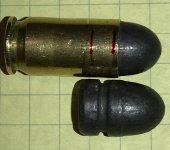DesertRatR,
Putting the ogive shoulder flush with the case mouth is not SOP in .45 Auto. Standard practice for ammo that has to fit any gun is to put the shoulder about 0.020" forward—about the thickness of a thumbnail—of the case mouth. The idea is that when the cartridge mouth stops against the chamber's throat shoulder, the small protruding rounded bullet shoulder will just start to enter the throat and thereby center the bullet in the bore for best accuracy. With lead, this is extra important because lead that is not centered well in the bore tends to distort and slightly imbalance as pressure swages it into the throat. I have experimented with this extensively and found getting the bullet centered in the throat to reduce sandbagged group diameters by about 40%. It also dramatically reduced leading for me, especially with the softer swaged bullets.
Now the rub. A great many .45 Auto pistols have loose headspace, so the cartridge case mouth does not reach the chamber shoulder before the extractor hook catches the case rim and stops the cartridge moving forward. In other words, they headspace on the extractor hook. Even if your particular gun does not have this common problem, if you reload your brass much, eventually it will. This is because the low pressure round does not stick its case to the chamber walls when firing. Instead, the case backs up into the breech face and pressure widens it to fill the back of the chamber, which pulls brass back from the side walls, which makes the case shorter. When you resize, it mostly recovers its length, but not all. In the early 90's, I monitored 500 pieces of Winchester cases I used for light target loads through 50 reload cycles before it was splitting so frequently it had to be retired. It was all about 0.025" shorter by then; about half a thousandth shorter after each load cycle. The SAAMI standard calls for .45 Auto brass to be 0.888-0.898" long to headspace on a case mouth correctly. If I have a batch that starts out in the middle of that tolerance rage, at 0.893", it's going to be below spec after the tenth loading and start headspacing on the extractor hook if it wasn't before.
When headspacing on the extractor hook, even with a 0.020" shoulder protrusion, a bullet is not typically centered well in the throat. Inaccuracy and leading are the result. To prevent this, I started headspacing on the bullet, instead. That means the bullet is out far enough so its shoulder meets the lands of the rifling before the case mouth finds the chamber shoulder or the rim finds the extractor hook. A soft lead bullet fired while in contact with the lands does not raise pressure appreciably. However, no two bullet designs and not two guns take to this identically. So, to headspace on the bullet you need to use the individual gun's barrel as the gauge. The correct seating depth is reached when a cartridge placed in the chamber has the face of its case head flush with the back end of the barrel, as shown in the third image from the left, below. With a long bullet shape, this sometimes has the bullet seated out so far that the magazine doesn't fit and feed it properly, and in that case you start with the bullet positioned to produce the case head position in that image, then slowly seat it deeper until it loads and feeds again. There is a short distance over which you still get some improvement over the performance of extractor hook headspacing.

Note that bullets seated this way will not fit properly in all chambers. This is a custom load. Also, because lead is soft, you no longer hear a resounding "plunk" when you drop the rounds into the chamber; the lead cushions the landing. But, as I said earlier, it cut sandbag groups at 25 yards by 40% for me and leading issues I'd had, particularly with swaged bullets, essentially ceased. There were little lead streaks still present in the throat, but once established, they seem to stop building up. By way of experiment, I have twice put about 3,000 rounds of LSWC through on of my 1911's over a three day period without lead building up. Powder fouling finally caked up in the slide and frame enough to caused the slide to stop going fully into battery without thumb assist. At that point I cleaned it.

